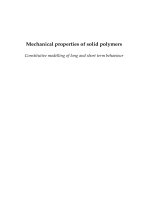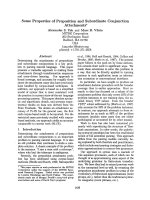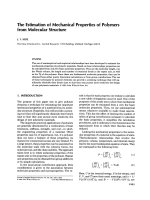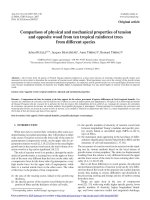Mechanical properties of polymers and composites-Nielsen Episode 8 docx
Bạn đang xem bản rút gọn của tài liệu. Xem và tải ngay bản đầy đủ của tài liệu tại đây (61.41 KB, 10 trang )
3
Creep and Stress Relaxation
I. INTRODUCTION
Creep and stress-relaxation tests measure the dimensional stability of a
material, and because the tests can be of long duration, such tests are of
great practical importance. Creep measurements, especially, are of interest
to engineers in any application where the polymer must sustain loads for
long periods. Creep and stress relaxation are also of major importance to
anyone interested in the theory of or molecular origins of Viscoelasticity.
For elastomeric materials, extremely simple equipment can be used to
measure creep or stress relaxation. For rigid materials the measurements
become more difficult, and more elaborate equipment is generally re-
quired. In the creep of rigid materials, the difficulty arises from the ne-
cessity to measure accurately very small deformations and deformation
rates. In the case of the stress relaxation of rigid polymers, the problem
is to measure the stress and small strains accurately when the specimen is
comparable in rigidity to that of the apparatus, in which case small defor-
mations of the apparatus or slippage of the specimen in its grips can in-
troduce very large errors. A great many instruments have been described
in the literature. Instruments and techniques, together with many refer-
ences, have been described in detail by Ferry (1) and Nielsen (2) and are
not reviewed here. However, most modern testing laboratories have com-
mercial "universal" testing machines that can make such measurements,
63
64 Chapter 3
especially if electronic or optical strain gages are used properly to measure
the longitudinal and lateral strain. Unfortunately, creep measurements
tend to be made at constant force or load and not constant stress (whether
using simple or complex test equipment). One should try to ensure that
the proper data are being supplied for and used in analyses.
If the deformations and stresses are small and the time dependence is
weak, creep ami stress-relaxation tests are essentially the inverse of one
another. Otherwise data from one kind of test can be used to calculate the
other by fairly complex methods to be described later. However, to a first
approximation the intcrconversion from creep to stress relaxation, or vice
versa, is given by a simple equation (3):
where €„ is the initial strain in a creep test and e(() is the creep strain after
time I. <r
0
is the initial stress measured at the beginning of a stress-relaxation
test, and cr(/) is the stress after time /. This equation works better in regions
of small time dependence (i.e., in the glassy region, in the rubbery region,
or with crystalline materials). The creep response lies at longer times than
does inverse stress relaxation. This small difference is accounted for in the
more complex calculation methods, but should be kept in mind if equation
(I) is used.
When the stresses and strains become large and the stress-strain curve
becomes nonlinear, simple descriptions of the response and interconversions
between creep and relaxation become increasingly less valid. Published dis-
cussions of nonlinear Viscoelasticity in melts, elastomers, and glassy solids all
treat or emphasize
1
different aspects ol nonlineaiity. The problem is still under
active investigation, with the greatest progress having been made with elas-
tomers and the least progress with glassy solids. Of course, the response of
two-phase systems is, by the same token, even less well understood. Despite
this, such materials can be described to a useful extern by straightforward
mechanics. The problem that can arise, however, is in trying to describe (1)
how the materials will react to a complex stress or strain field if only knowledge
of the response in simple tension or simple shear is available, and (2) what
the long-time response will be. In the following section the discussion will
rely on understanding gairted at the linear viscoelastic level. The degree to
which it can be extrapolated outside this region must be kept in mind.
II. MODELS
Very simple models can illustrate the general creep and stress-relaxation
behavior of polymers except that the time scales are greatly collapsed in
the models compared to actual materials. In the models most of the in-
Creep and Stress Relaxation 65
teresting changes occur in about one decade of time, whereas polymers
show (he same total changes only over many decades of time. Nevertheless
such models provide a useful mnemonic device for describing or recalling
the interplay between viscous and elastic response and for the underlying
simple differential equations that describe stress-strain-time relations in
linear Viscoelasticity. At the same time, they provide a useful means of
visualizing responses.
A simple model for stress relaxation is a Maxwell unit, which consists
of a Hookean spring and a Newtonian dashpot in series as shown in the
insert in Figure 1. The modulus or stiffness of the spring is E, and the
viscosity of the dashpot is r\. In a stress-relaxation experiment the model
is given a definite strain e while the stress <r is measured as a function of
time. In the strained model, the change of the elongation of the spring is
compensated by an equal change in the dashpot, but the net rate of change
is zero; that is.
Figure 1 Stress relaxation of a Maxwell model (linear scales), T = 1 s.
66 Chapter 3
where
The quantity T is called the relaxation time.
Equation (3) is plotted with two different time scales in Figures 1 and
2 for values somewhat typical of an elastomer. All the initial deformation
takes place in the spring; at a later time the dashpot starts to relax and
allows the spring to contract. Most of the relaxation takes place within one
decade of time on both sides of the relaxation time, but this is shown clearly
only in Figure 2. On the logarithmic time scale, the stress-relaxation curve
has a maximum slope at the time / = T and the stress ratio cr/cr,, is 0.3679
ore '. The stress relaxation may also be given in terms of a stress-relaxation
modulus E
r
(t):
The model of Figure I cannot describe creep behavior at all. This may be
illustrated by the four-element model shown in Figure 3. When a constant
load is applied, the initial elongation comes from the single spring with the
modulus E,. Later elongation comes from the spring E
2
and dashpot T]
2
,
in parallel, and from the dashpot with the viscosity r\
?
. The total elongation
Figure 2 Stress relaxation of a Maxwell model on a logarithmic time scale. Model
is the same as Figure 1.
Figure 3 Four-clement model for creep.
of the model is the sum of the individual elongations of the three parts.
Thus
where cr
0
is the applied stress and the retardation time T is defined by
In a recovery test after all the load is removed at time /,, the creep is all
recoverable except for the flow that occurred in the dashpot with viscosity
The instant the load is removed there is a reduction in the elongation
of the model equal to aJE
x
. The equation for subsequent creep recovery
is
where
Creep and Stress Relaxation 67
68 Chapter 3
Figure 4 illustrates the creep and recovery of a four-element model with
the following constants:
The creep experiment lasted 1(K) s and then the load was removed for the
recovery experiment.
Figures 5 and h show how the shape of the creep curve is modified by
changes in the constants of the model. The values of the constants are
given in Table I. Curve I is the same as shown in Figure 4, curve II shows
onlv a small amount of viscous creep, and in curve 111, viscous flow is a
prominent part of the total creep. The same data were used in Figures 5
and 6, but notice the dramatic, change in the shapes of the curves when a
linear time scale is replaced by a logarithmic time scale. In the model, most
of the recoverable creep occurs "Within about one decade of the retardation
time.
In Chapter 4, the response of these models to dynamic (i.e., sinusoidal)
loads or strains is illustrated. In Chapter 5, the stress-strain response in
constant rate experiments is described. Models with nonlinear springs and
nonlinear dashpots (i.e., stress not proportional to strain or to strain rate)
Figure 4 Creep and creep recovery of a four-clement model.
Creep and Stress Relaxation 69
Figure 5 Creepi of a four-element model with the constants given in Table 1~
Linear time scale.
in which the nonlinearity is taken to be associated with specific mechanisms
such as springs with rubberlike elasticity have also been employed (4).
III. DISTRIBUTION OF RELAXATION AND
RETARDATION TIMES
In Section II, models were discussed that had only a single relaxation or
retardation time. Actual polymers have a large number of relaxation or
retardation times distributed over many decades of time. E(t) is then the
sum of individual contributions, so equation (5) becomes
Models purporting to describe reai material behavior with only a small
number of values of T will provide illustrative calculations of the response
only over a small time or temperature region. Such illustrative results can
be extremely important in providing guidance as to potential trends in
response. However, the models can never be used for reliable estimates
of response under real use conditions over wide time or temperature ranges.
TIME (SEC)
Figure 6 Creep of a four-element model with the same constants as in Figure 5
but with a logarithmic time scale.
For real polymers with large N, the summation passes over to an integral
and E, is replaced by a continuous set of contributions to the modulus
associated with each time increment between
F(i) is the underlying modulus spectrum for that system. As noted above,
since the time scale of relaxation is so broad, results are best depicted on
a logarithmic time scale. To do this, one needs the contribution to the
modulus associated with or'lying in the time interval between In T and In
T 4- d In T; this incremental contribution to the modulus is designated as
70 Chapter 3
Creep and Stress Relaxation 71
The continuous function H(\n T) [often simply given the symbol H(r) as
in this chapter) is the continuous relaxation spectrum. Although called, by
long-standing custom, a spectrum of relaxation times, it can be seen that
H is in reality a distribution of modulus contributions, or a modulus spec-
trum, over the real time scale from 0 to <« or over the logarithmic time
scale from
The distribution of relaxation times H(r) can be estimated from a stress
relaxation or E
r
(() curve plotted on a log t scale by
A distribution obtained by the use of equation (13) is only a first approxima-
tion to the real distribution. The corresponding distribution of retardation
times is designated as L(T). It may be estimated from the slope of a com-
pliance curve D(() or J(t), for tensile or shear creep, respectively, plotted
on a logarithmic time scale according to the equation (for shear creep)
If there is any viscous flow component to the creep, it should be removed
before making the calculation, so
For tensile creep, TJ would be the tensile viscosity. When the viscosity is
high (e.g., when working at relatively low temperatures or with very high-
molecular-weight polymers) it can be difficult to determine tl-x\ accurately,
so creep recovery measurements are made. Here the load is released after
a given creep time and the strain is followed as the specimen shrinks back
toward its new equilibrium dimensions.
Equations (13) and (14) can be used to obtain quick estimates and to
visualize the response of a polymer system under investigation. In any case,
unless D{t) and E(t) are varying very slowly on a log time scale, the dis-
tributions are valid only in the time range from the minimum time of
observation, plus one decade, to the maximum time^of observation, less
one decade. Many more accurate and complex methods of estimating L(r)
and //(T) have been proposed. These methods have been summarized by
72 Chapter 3
various authors, including Leaderman (5), Ferry (1), and Tobolsky (6),
and presented more recently in great detail by Tschoegl (7).
To get accurate distributions of relaxation or retardation times, the
expetimcntal data should cover about 10 or 15 decades of time. It is im-
possible to get experimental data covering such a great range of times at
one temperature from a single type of experiment, such as creep or stress
relaxation
Therefore, master curves (discussed later) have been developed
that cover the required time scales by combining data at different temperatures
through the use of time-temperature superposition principles.
Distributions of relaxation or retardation times are useful and important
both theoretically and practically, because // can be calculated from / (and
vice versa) and because froni such distributions other types of viscoelastic
properties can be calculated. For example, dynamic modulus data can be
calculated from experimentally measured stress relaxation data via the
resulting // spectrum, or H can be inverted to L, from which creep can
be calculated. Alternatively, rather than going from one measured property
function to the spectrum to a desired property function [e.g., E(t) —* //{In
Schwarzl has presented a series of easy-to-use approximate
equations, including estimated error limits, for converting from one prop-
erty function to another (11).
From the practical standpoint of trying to solve stress analysis problems,
even when they
however, verv little use has been- made of
are known. The reason is that at each step in time, integration over the
or
has to be carried out. It is easier, instead, to use
whole range of
The exponential series in equation (10), called a Prony series, is an
attractive explicit representation of /:(/), extremely useful in numerical
calculation. However, although it can describe E{t) with great fidelity and
accuracy if
and N are known, a known set of
data cannot be
inverted analytically to determine the coefficients. Approximate numerical
techniques called colocation methods (12) have been developed which,
values, will fit the experimental data very well for data
using preselected
that vary slowly (i.e., near the rubbery or glassy region). However, they
are unreliable in fitting data though a full transition region. Many people
have written computer programs for these and related computations/trans-
formations, but few appear to be commercially available.
The methods described above give continuous distributions of relaxation
times. However, the molecular theories of Viscoelasticity of polymers as









